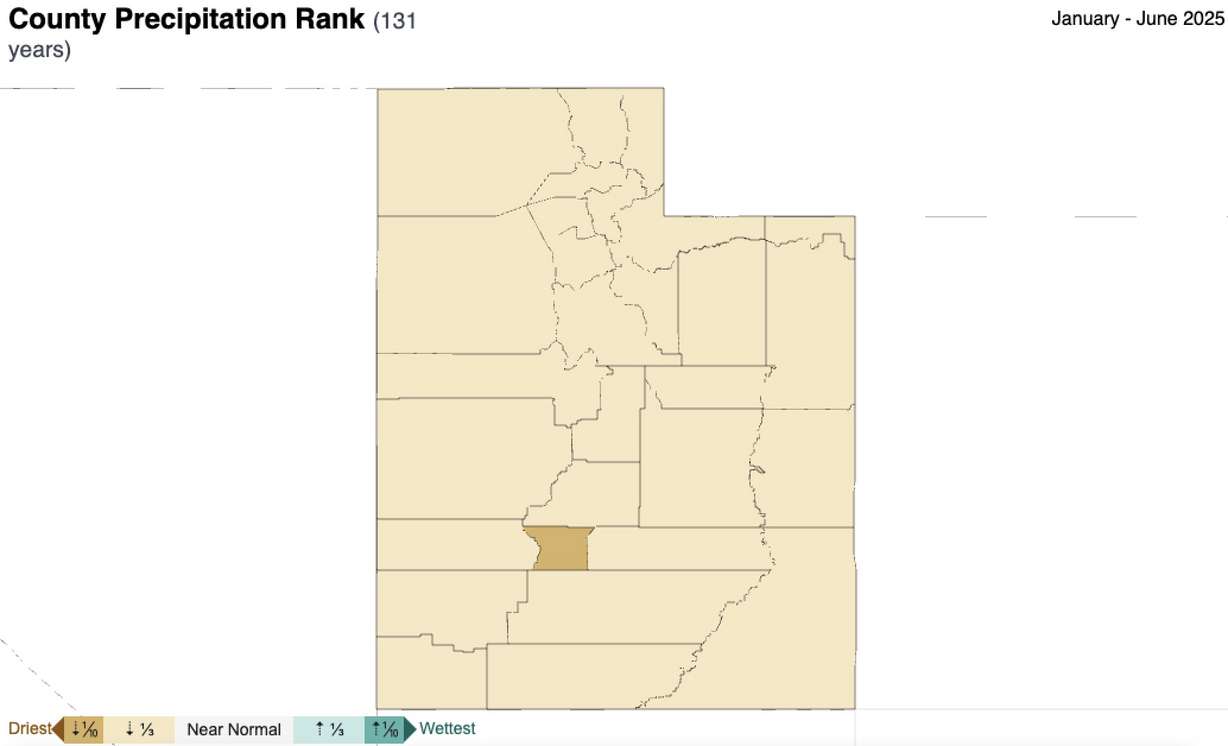Estimated read time: 4-5 minutes
- Over half of Utah is in severe drought, while the rest is in moderate drought.
- Utah's 2025 precipitation is 2.67 inches below 2024's halfway point, factoring in the worsening drought conditions.
- About 86% of the West is abnormally dry or in drought, which is impacting water resources in other states.
SALT LAKE CITY — More than half of Utah is now in severe drought, but it is far from the only Western state experiencing dry conditions, as drought conditions worsen across the region.
About 52% of the Beehive State is now in severe drought, while the rest remains in moderate drought, the U.S. Drought Monitor reported on Thursday. It comes as new federal data shows exactly how dry the first half of the year has been.
Utah collected an average of 4.71 inches of precipitation throughout the first half of the year, which puts the 2025 calendar year on pace to be the state's 17th driest since at least 1895, according to data from the National Centers for Environmental Information.
The state averaged 6.74 inches between Jan. 1 and June 30 over the past 30 years. This year's running total is 2.67 inches below the halfway point of 2024 and 4.55 inches below 2023, but over an inch above 2022. Utah is also on track for its 12th-driest water year, going back to the start of it on Oct. 1, 2024.
With an average temperature of 46.4 degrees, Utah is also on track to have its eighth-warmest year on record. The warmer and drier conditions have translated to lower water levels and increased fire danger.

Utah's reservoir system is 79% full, which is about 6 percentage points above the median average for this point in the year, but 12 points below the systemwide total this time last year. Besides Lake Powell, at least seven reservoirs in the state have already dropped below 40% capacity, according to the Utah Division of Water Resources.
Over 500 wildfires have started this year, which have burned close to 58,000 acres, state and federal firefighters also report. The conditions became severe enough that Gov. Spencer Cox called on Utahns of all faiths to pray for rain and take steps to reduce water consumption.
"Small actions, taken together, can make a big difference for our stats," he said last month.
The good news is that what happens in the first half of the year doesn't always mean the same trend will linger into the second half.
In 2022, for example, Utah followed its third-driest first half by posting its 33rd-wettest second half on record. It got the ball rolling for what would end up being a record-setting snowpack the following year. Utah's ninth-driest first half and ninth-wettest second half on record both came in 2021.
The rest of the West
Meanwhile, 86% of the West is at least "abnormally dry," including nearly two-thirds of the region that is also in some form of drought.
The figure is based on conditions across Utah, Arizona, California, Colorado, Idaho, Montana, Nevada, New Mexico, Oregon, Washington and Wyoming. Only eastern pockets of Colorado, Montana, New Mexico and Wyoming remain out of any category, along with a section of Northern California.
While Utah remains the only state entirely consumed by drought, more serious categories have formed in other parts of the West. About 12% of the region is in extreme or exceptional drought. Most of this can be found in the Southwest, especially in Arizona and southwest New Mexico, but there are also a few pockets within the Mojave Desert, western Colorado, northern Idaho and western Montana.

The Southwest's plight isn't much of a surprise after a lackluster snowpack. Arizona, New Mexico and Colorado benefited the most from monsoonal storms in June, all of which ended up with near-normal or above-normal precipitation totals.
But those have yet to make a significant drought dent for most parts of those states, and many showers have also ended up toward the eastern portion of the region or east of the region entirely. This includes the remnants of Tropical Storm Barry and Hurricane Flossie that produced Texas's devastating flooding last week.
It's a different story for the Pacific Northwest after parts of the region — especially Oregon — received a strong snowpack. Last month was Oregon's 10th driest June on record, while Idaho had its sixth-driest and Washington had its third-driest June on record. The region experienced its third-driest meteorological spring in the three months before that.
It's why drought has quickly returned to the region. All of Oregon is at least abnormally dry, including over 40% in drought, after no parts of the state were in any category three months ago.
The sudden drought has created "rapidly declining soil moisture and low 28-day average streamflows" across the region, Brad Pugh, a drought meteorologist with the National Oceanic and Atmospheric Administration's Climate Prediction Center, wrote in a Drought Monitor report on Thursday.
"The drought conditions are putting stress on our drinking water supplies, as well as the fish and wildlife that depend on water in our streams," Lincoln County, Oregon, commissioners said in a statement on Tuesday, after declaring an emergency over the matter.
All of it comes as the West has dealt with a series of droughts since about 2000, known as a "megadrought." A 2022 study found that the region's megadrought was its worst in 1,200 years.









